The Modern Kitchen Dilemma: A Sea of Cords
Let’s face it, the modern kitchen is a technological marvel. From blenders and food processors to smartphones and tablets displaying recipes, our countertops are brimming with devices designed to make our lives easier. But all this technology comes with a price: a tangled web of charging cables that transforms our kitchens into a chaotic mess. The once-sacred space dedicated to culinary creativity now resembles a digital jungle, a constant source of frustration and visual clutter. We’ve all been there, haven’t we? Searching for the right charger, untangling knots that seem to defy the laws of physics, and desperately trying to hide the unsightly cords behind appliances. It’s a daily battle many of us are tired of fighting. This is where the brilliance of a charging drawer comes in—a simple yet revolutionary solution to reclaim your kitchen space and restore order to your culinary domain.
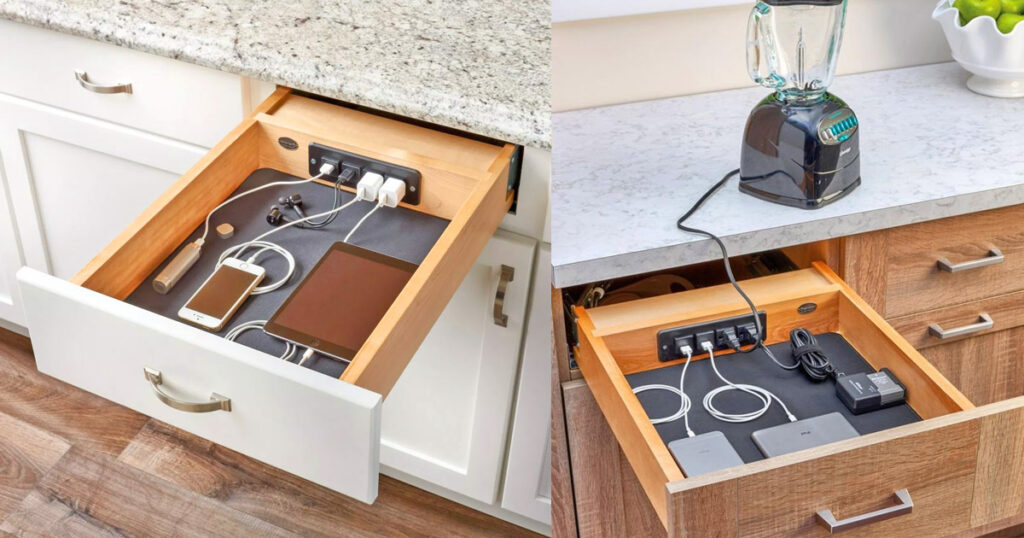
Imagine a kitchen where your devices are neatly tucked away, charging wirelessly or via designated ports, all within a concealed drawer. No more unsightly cords snaking across the countertop, no more scrambling for outlets, and no more visual clutter stealing the joy from your cooking experience. This isn’t just a dream; it’s the reality that a charging drawer offers. It’s about creating a functional and aesthetically pleasing kitchen, a space where you can focus on what truly matters: creating delicious meals and enjoying time with loved ones.
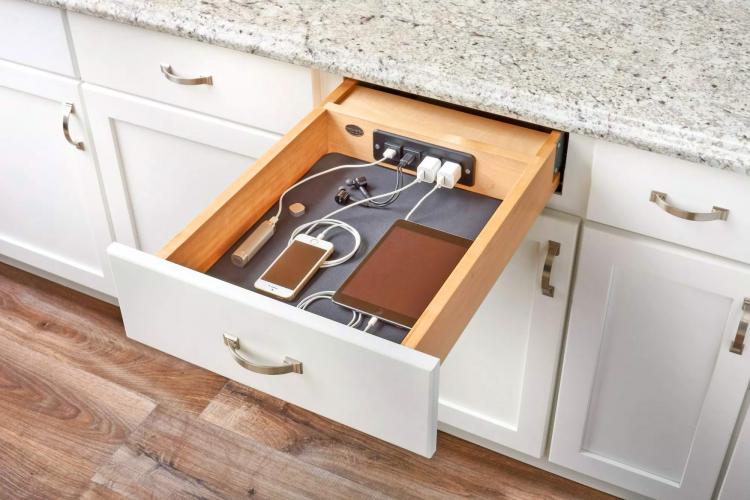
What is a Charging Drawer? Unveiling the Hidden Powerhouse
At its core, a charging drawer is simply a modified kitchen drawer equipped with electrical outlets and/or USB ports designed for charging electronic devices. Think of it as a dedicated charging station hidden within your cabinetry. These drawers can be custom-built or purchased as pre-fabricated units, offering flexibility to suit different kitchen layouts and needs. Some even incorporate wireless charging pads for compatible devices, adding another layer of convenience. The key lies in its ability to conceal the charging process, keeping your countertops clean and clutter-free. The beauty is in the simplicity and the seamless integration into your existing or planned kitchen design.
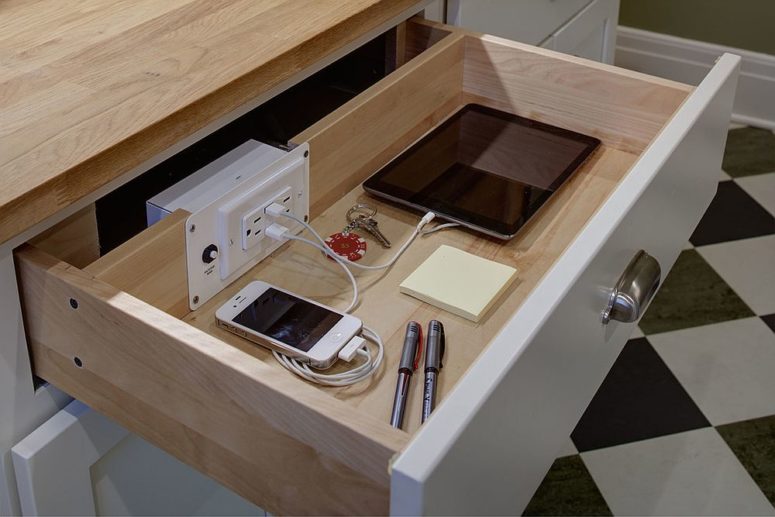
Benefits Beyond Aesthetics: Why You Need a Charging Drawer
While the aesthetic appeal of a clutter-free countertop is undeniable, the benefits of a charging drawer extend far beyond just appearances. Here’s a closer look at why incorporating this innovative feature into your kitchen is a game-changer:
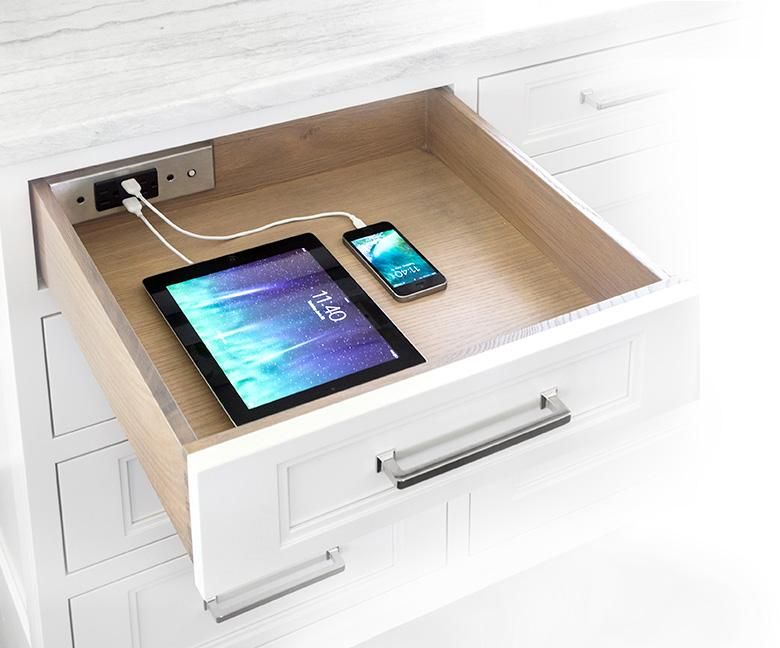
- Decluttered Countertops: This is the most obvious benefit. By consolidating your charging devices in a designated drawer, you free up valuable countertop space for food preparation, appliances, and decorative items.
- Organized Charging: No more hunting for the right charger or dealing with tangled cords. Everything is neatly organized and readily accessible within the drawer.
- Increased Safety: Loose cords can be a tripping hazard, especially in a busy kitchen. A charging drawer keeps cords contained and out of harm’s way, promoting a safer environment.
- Protection for Devices: By keeping devices tucked away in a drawer, you protect them from spills, splashes, and accidental damage that can occur on the countertop.
- Enhanced Aesthetics: A charging drawer contributes to a more streamlined and visually appealing kitchen design. It shows attention to detail and elevates the overall look and feel of the space.
- Increased Property Value: Modern features like charging drawers can increase the appeal and value of your home, making it a worthwhile investment.
- Convenience and Efficiency: Having a dedicated charging station in your kitchen makes it easy to keep your devices powered up and ready to go. You can charge your phone while cooking, listen to music, or follow recipes without worrying about battery life.
Choosing the Right Charging Drawer: Factors to Consider
Selecting the perfect charging drawer for your kitchen requires careful consideration of several factors. Here’s a breakdown of the key elements to keep in mind:
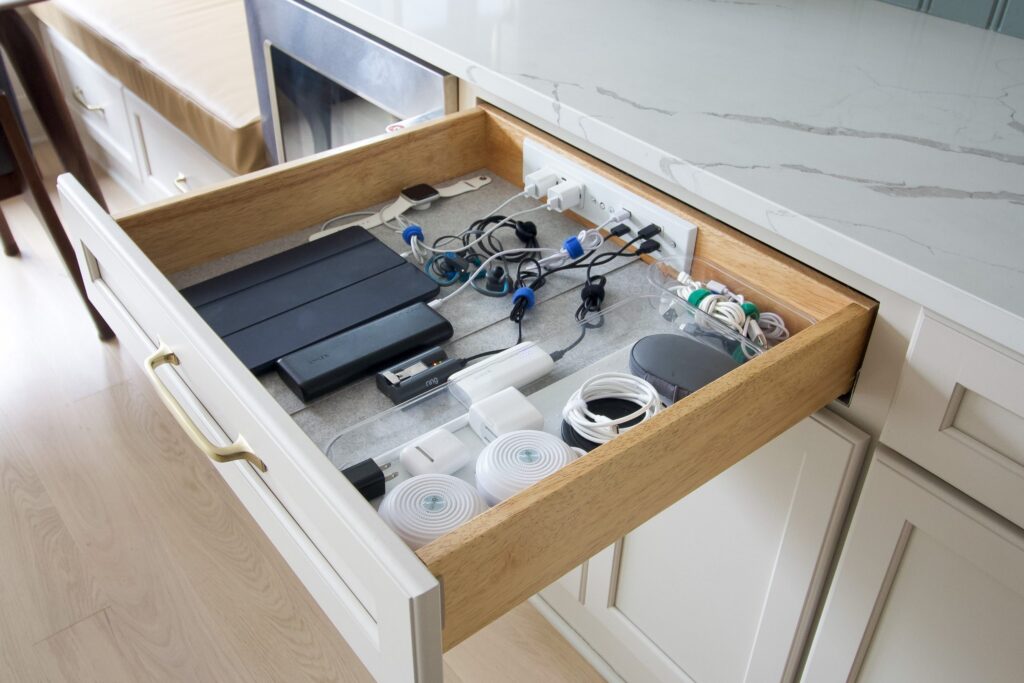
Size and Configuration
The size of your charging drawer will depend on the number and types of devices you plan to charge. Consider the dimensions of your smartphones, tablets, e-readers, and other kitchen gadgets. You’ll also need to factor in the space required for the electrical components and any additional storage you might want within the drawer. Think about the depth, width, and height of the drawer and how it will fit into your existing or planned cabinetry. Pre-made charging drawers come in standard sizes, while custom-built options allow for greater flexibility. Determine if you prefer multiple smaller drawers or one large drawer. Consider internal dividers and compartments to keep devices separate and organized.
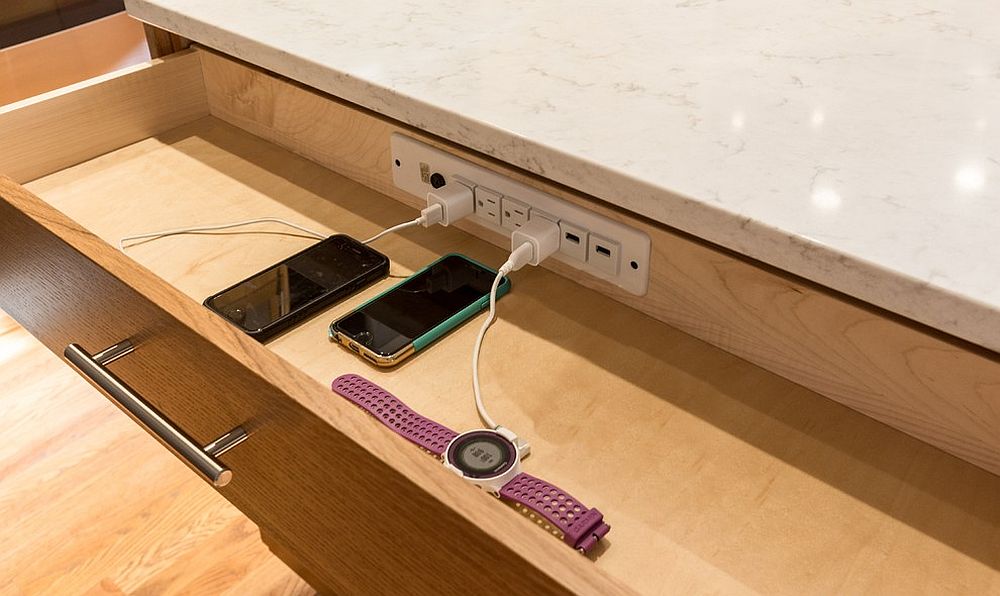
Electrical Requirements and Safety
Ensure the charging drawer meets all relevant electrical safety standards and codes. It’s crucial to use high-quality electrical components and wiring that are properly grounded and protected against overloads. Consider the number of outlets and USB ports you’ll need, as well as the amperage of each outlet. A surge protector is a must-have to protect your devices from power spikes. If you’re installing the charging drawer yourself, be sure to follow all electrical safety guidelines and consult with a qualified electrician if you’re unsure about any aspect of the installation process. Pay attention to certifications like UL (Underwriters Laboratories) or ETL (Electrical Testing Laboratories) to ensure the product has been tested for safety.
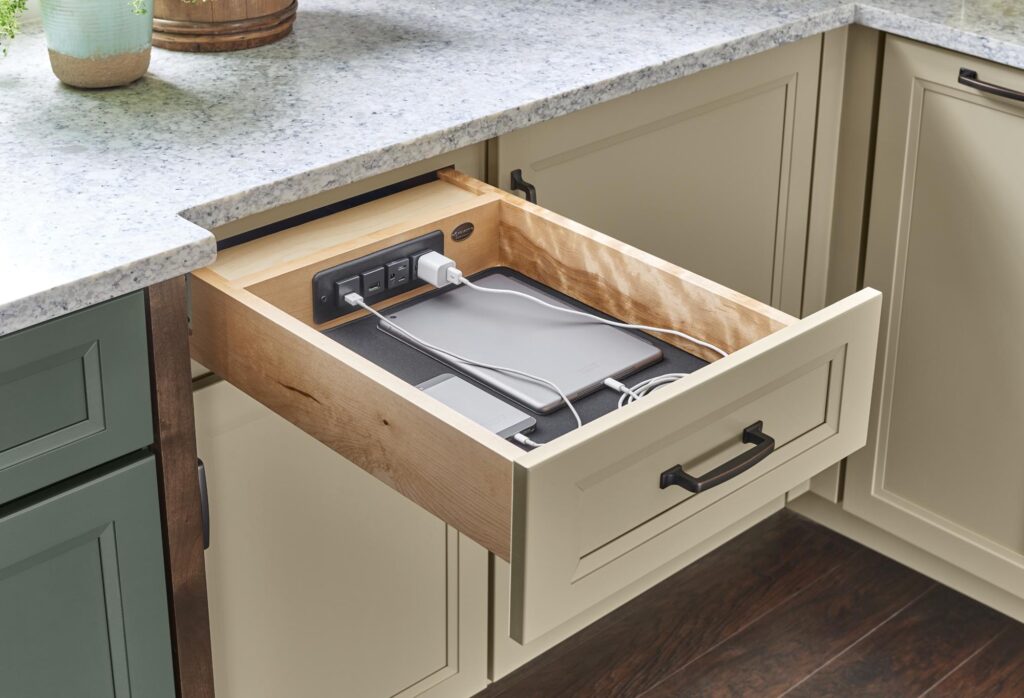
Outlet and Port Types
Determine the types of outlets and ports you’ll need to accommodate your devices. Standard AC outlets are essential for charging larger appliances and devices with traditional plugs. USB-A ports are still widely used, but USB-C ports are becoming increasingly common, offering faster charging speeds and greater compatibility. Some charging drawers also include wireless charging pads for Qi-enabled devices. Consider future-proofing your charging drawer by including a mix of outlet and port types to accommodate new devices as they become available. Look for outlets and ports that are easy to access and use, even when the drawer is partially closed.
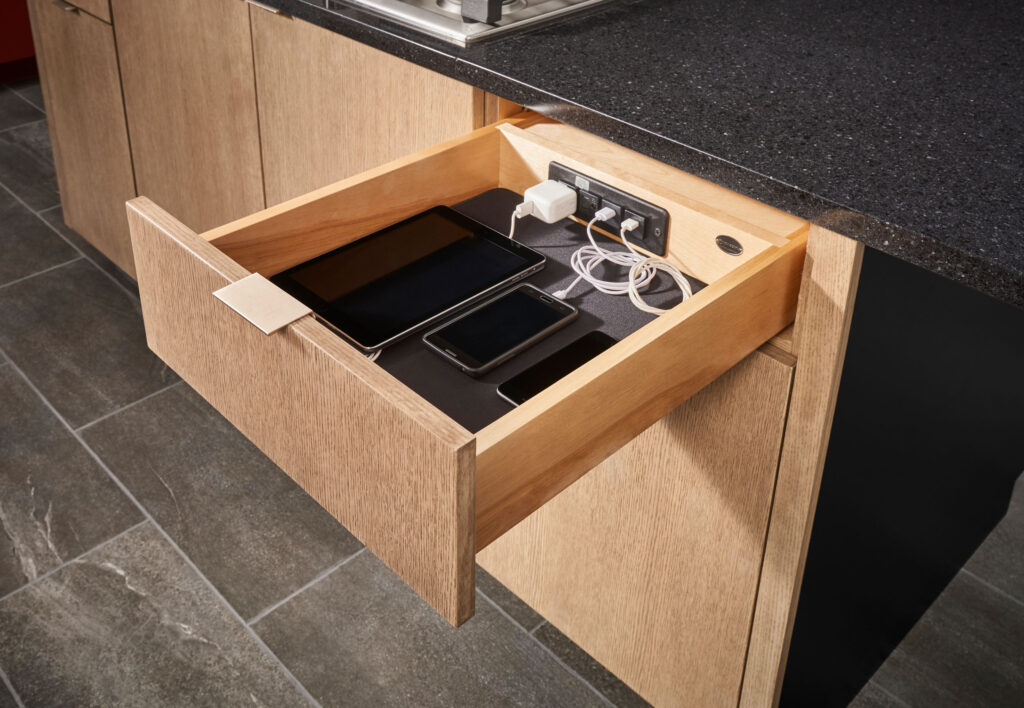
Materials and Durability
Choose a charging drawer made from durable and high-quality materials that can withstand daily use. Wood, metal, and laminate are common choices, each with its own advantages and disadvantages. Wood offers a classic and elegant look, but it may require more maintenance. Metal is durable and easy to clean, but it can be prone to scratches. Laminate is a cost-effective option that is resistant to moisture and stains. Consider the overall aesthetic of your kitchen and choose a material that complements your existing cabinetry and décor. Look for drawers with sturdy construction and smooth-gliding mechanisms that can handle the weight of multiple devices.
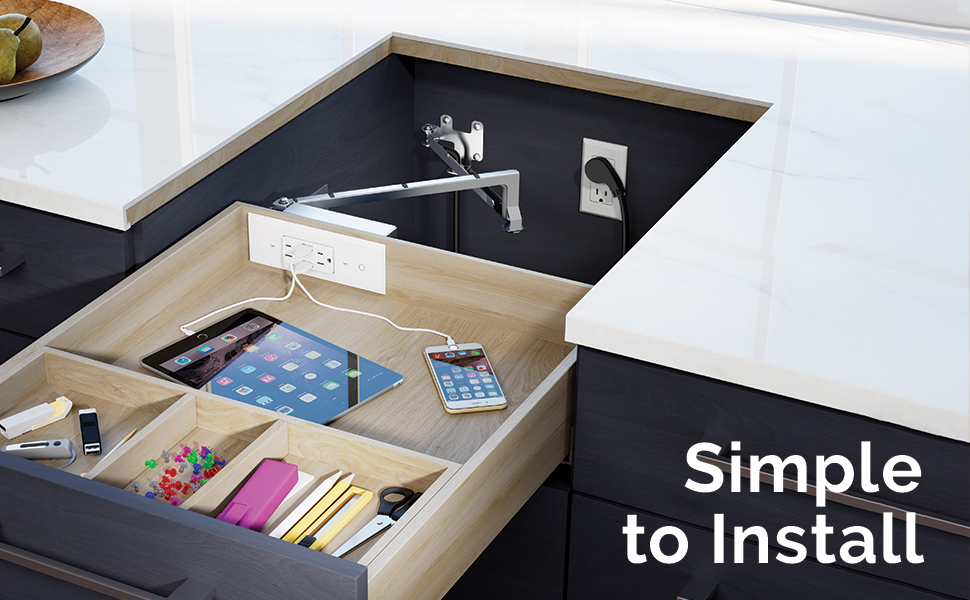
Placement and Installation
Carefully consider the placement of your charging drawer within your kitchen. Ideally, it should be located in a convenient and easily accessible area, close to where you typically use your devices. Avoid placing the drawer near water sources or areas prone to spills. The installation process will depend on whether you’re purchasing a pre-fabricated unit or building a custom drawer. Pre-fabricated units are typically easier to install, while custom-built options require more planning and expertise. If you’re not comfortable with electrical work, it’s best to hire a qualified electrician to handle the installation. Ensure that the drawer is properly aligned and secured to prevent it from wobbling or falling out.
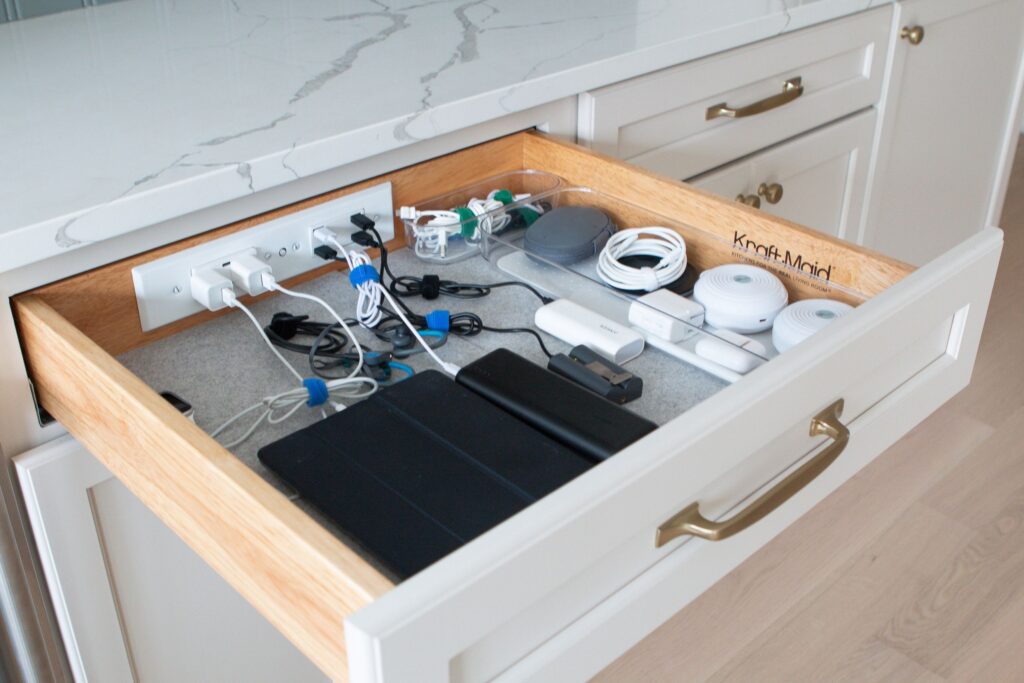
Aesthetics and Design
The charging drawer should seamlessly integrate into your kitchen’s overall design aesthetic. Choose a style and finish that complements your existing cabinetry and décor. Consider the color, hardware, and overall look of the drawer to ensure it blends in seamlessly. Some charging drawers are designed to be completely hidden, while others feature visible outlets and ports. Think about the level of visibility you prefer and choose a design that meets your needs. You can also customize the drawer with different types of drawer pulls and knobs to match your existing hardware.
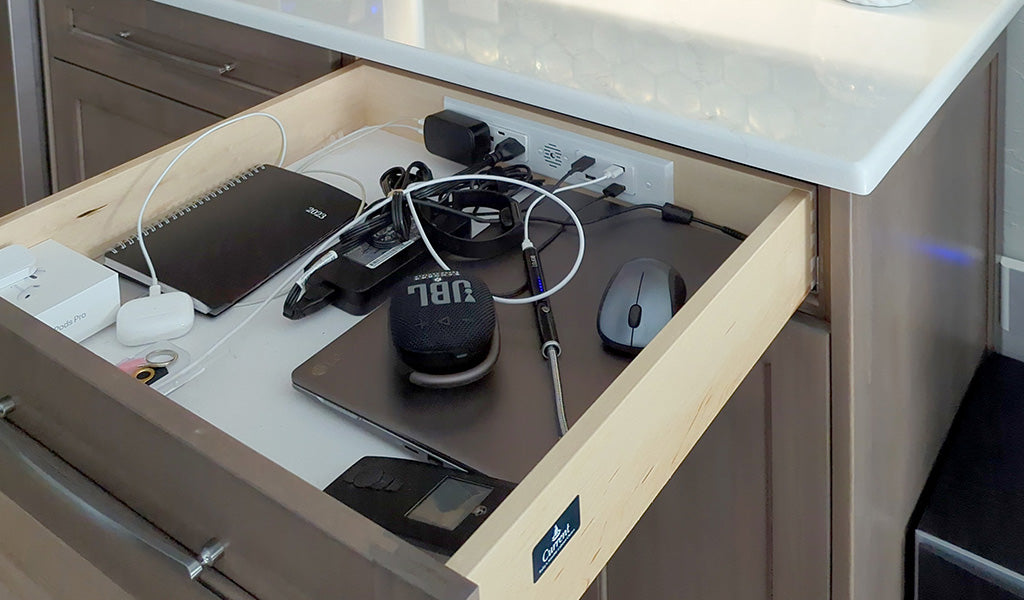
Budget
Charging drawers range in price from a few hundred dollars for basic pre-fabricated units to several thousand dollars for custom-built options. Set a budget before you start shopping and stick to it. Consider the features and benefits that are most important to you and prioritize them accordingly. Don’t be afraid to shop around and compare prices from different retailers and manufacturers. Keep in mind that investing in a high-quality charging drawer is a worthwhile investment that will enhance the functionality and aesthetics of your kitchen for years to come.
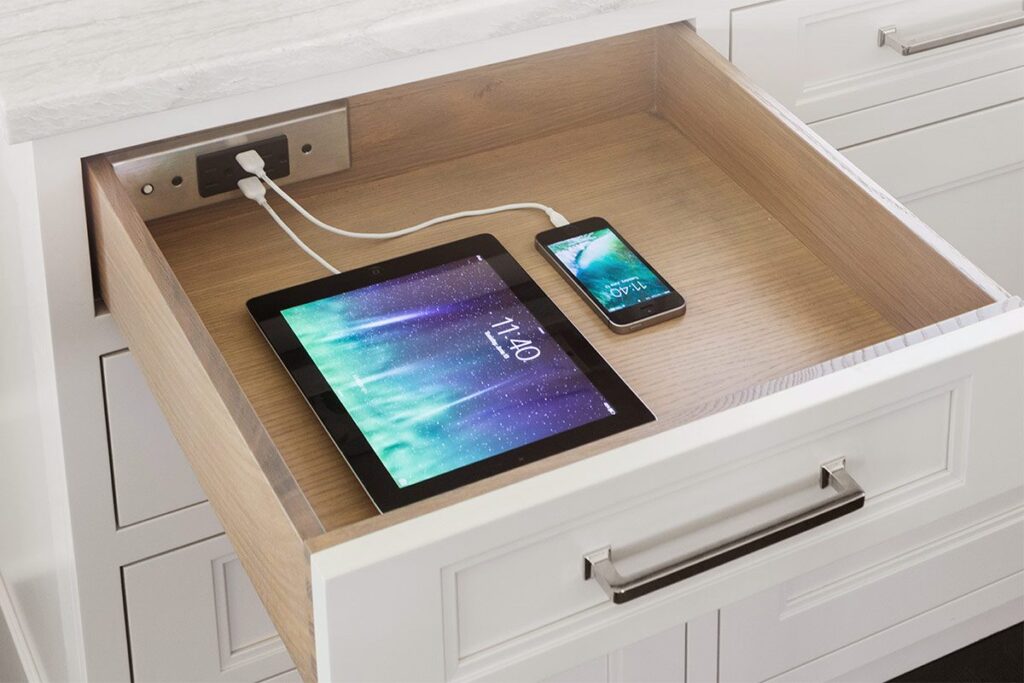
DIY vs. Pre-Built: Which Charging Drawer is Right for You?
You have two primary options when it comes to incorporating a charging drawer into your kitchen: building it yourself or purchasing a pre-built unit. Each approach has its own set of advantages and disadvantages, so it’s important to weigh your options carefully before making a decision.
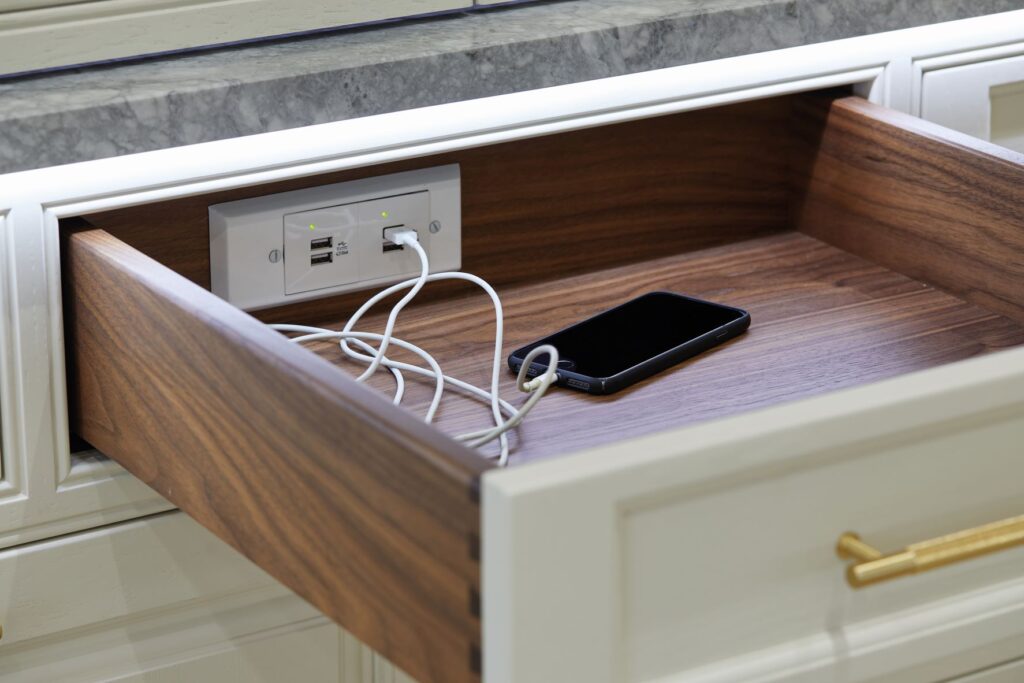
DIY Charging Drawer: A Customized Approach
Building a charging drawer yourself allows for complete customization to fit your specific needs and preferences. You have full control over the size, configuration, materials, and design of the drawer. This is a great option if you have unique space constraints or if you want to match the drawer perfectly to your existing cabinetry. However, DIY projects require a certain level of skill and experience in woodworking, electrical wiring, and cabinet making. You’ll also need to invest in the necessary tools and materials, which can add to the overall cost. Safety is paramount when working with electricity, so it’s crucial to follow all electrical safety guidelines and consult with a qualified electrician if you’re unsure about any aspect of the project.
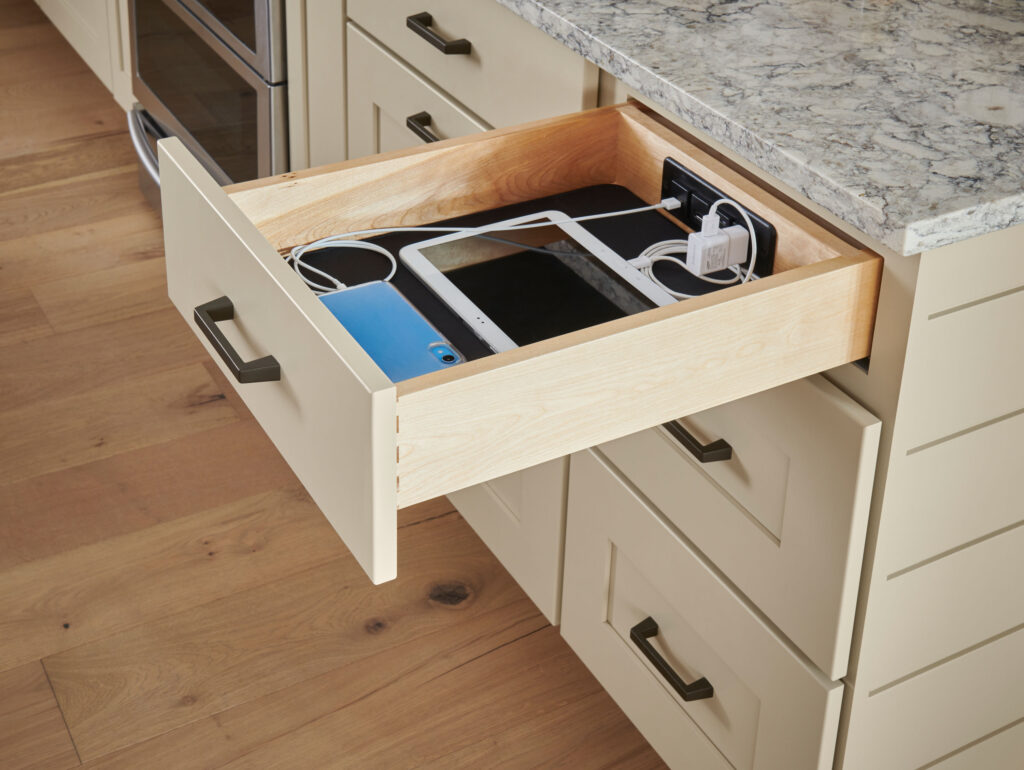
Pros of DIY Charging Drawers:
- Complete Customization: Design the drawer to perfectly fit your needs and preferences.
- Cost Savings: Potentially save money on labor costs.
- Personal Satisfaction: Enjoy the satisfaction of building something yourself.
Cons of DIY Charging Drawers:
- Requires Skill and Experience: Woodworking and electrical wiring skills are necessary.
- Time-Consuming: Building a charging drawer can take several days or even weeks.
- Potential Safety Hazards: Electrical work can be dangerous if not done properly.
Pre-Built Charging Drawer: Convenience and Efficiency
Purchasing a pre-built charging drawer offers convenience and efficiency. These units are typically designed and manufactured by professionals, ensuring quality and safety. They are also relatively easy to install, often requiring minimal assembly. Pre-built charging drawers come in a variety of styles, sizes, and configurations, making it easy to find one that meets your needs. However, pre-built units may not offer the same level of customization as DIY options. You may also need to compromise on certain features or design elements to find a unit that fits your budget and space constraints.
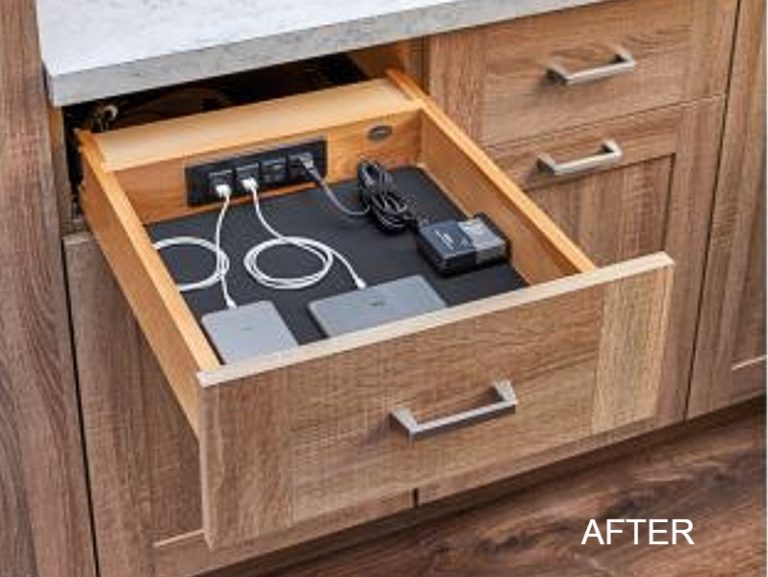
Pros of Pre-Built Charging Drawers:
- Convenience: Easy to purchase and install.
- Quality and Safety: Designed and manufactured by professionals.
- Variety of Options: Available in different styles, sizes, and configurations.
Cons of Pre-Built Charging Drawers:
- Limited Customization: May not be able to customize the drawer to your exact specifications.
- Higher Cost: Typically more expensive than DIY options.
- Potential Compromises: May need to compromise on certain features or design elements.
Essential Features to Look for in a Charging Drawer
Whether you opt for a DIY or pre-built charging drawer, there are certain essential features you should look for to ensure functionality, safety, and convenience:
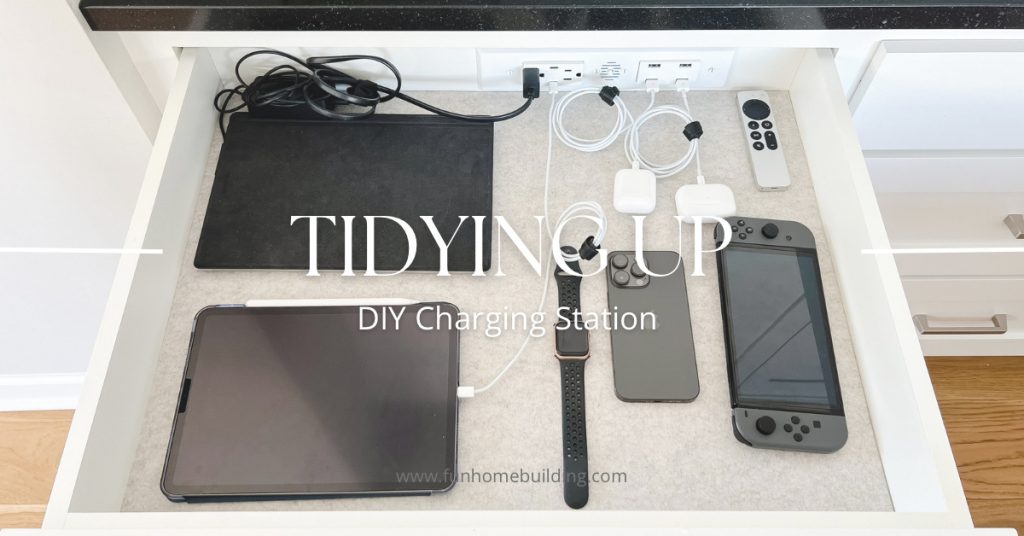
- Multiple Outlets and Ports: Ensure the drawer has enough outlets and USB ports to accommodate all your devices.
- Surge Protection: A surge protector is essential to protect your devices from power spikes.
- Cord Management: Look for features like cord organizers or channels to keep cords neatly contained.
- Ventilation: Proper ventilation is important to prevent devices from overheating while charging.
- Safety Mechanisms: Ensure the drawer has safety mechanisms like child-resistant outlets and overload protection.
- Soft-Close Drawers: These prevent slamming and protect your devices from damage.
- Wireless Charging Pad (Optional): For added convenience, consider a charging drawer with a built-in wireless charging pad.
Tips for Installing Your Charging Drawer
Whether you’re installing a pre-built charging drawer or a DIY creation, here are some helpful tips to ensure a smooth and successful installation:
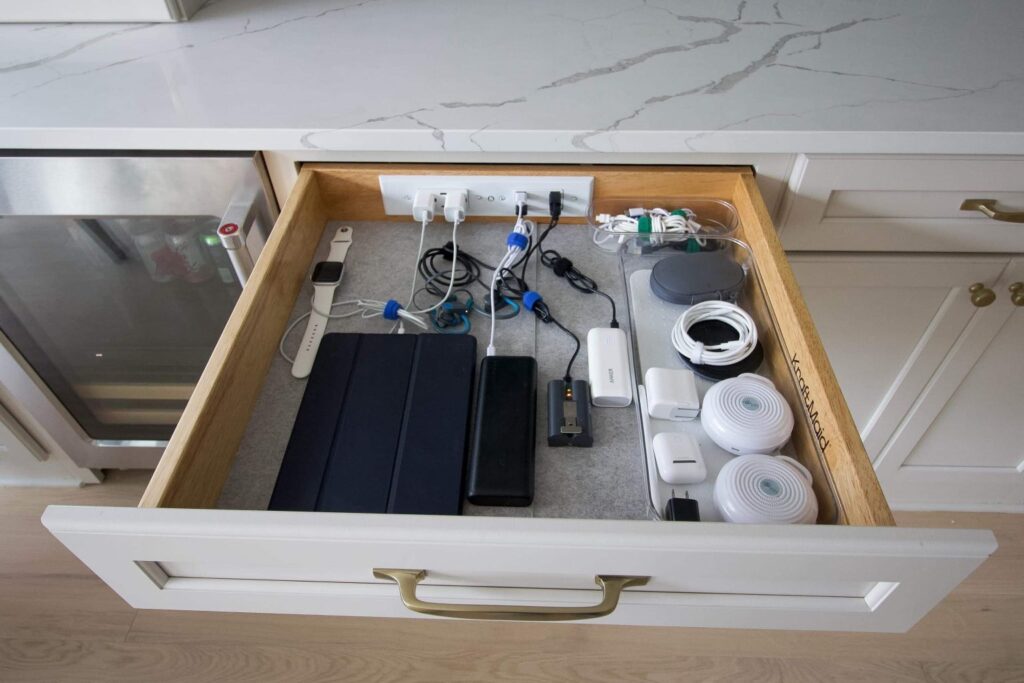
- Turn Off the Power: Always turn off the power to the circuit you’ll be working on before starting any electrical work.
- Follow Instructions Carefully: Read and follow all installation instructions provided by the manufacturer.
- Use the Right Tools: Make sure you have the right tools for the job, including a screwdriver, drill, wire stripper, and voltage tester.
- Check for Wiring: Before drilling or cutting into any surfaces, check for existing wiring or plumbing.
- Secure the Drawer Properly: Ensure the drawer is securely attached to the cabinetry to prevent it from wobbling or falling out.
- Test the Outlets: After installation, test all the outlets and USB ports to make sure they’re working properly.
- Consider Professional Help: If you’re not comfortable with electrical work, it’s best to hire a qualified electrician to handle the installation.
Maintaining Your Charging Drawer: Keeping it in Top Condition
To ensure your charging drawer lasts for years to come, it’s important to maintain it properly. Here are some tips for keeping your charging drawer in top condition:
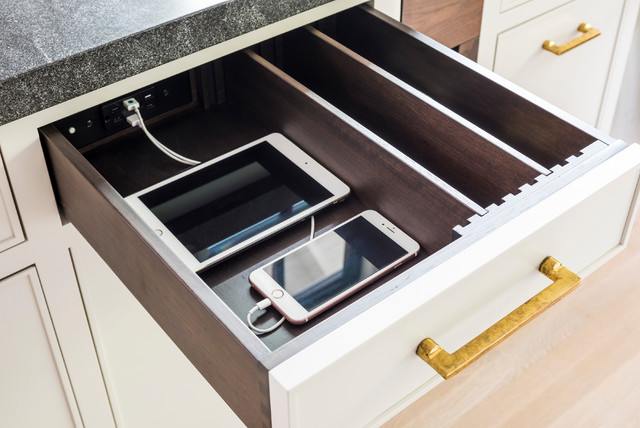
- Clean Regularly: Wipe down the drawer regularly with a damp cloth to remove dust and debris.
- Avoid Overloading: Don’t overload the outlets or USB ports, as this can damage the electrical components.
- Check for Loose Connections: Periodically check for loose connections and tighten them as needed.
- Replace Worn Cords: Replace any worn or damaged charging cords immediately.
- Keep it Dry: Avoid spills and splashes near the charging drawer, and keep it dry at all times.
Beyond the Kitchen: Charging Drawers in Other Areas of the Home
While charging drawers are particularly useful in the kitchen, their versatility extends to other areas of the home as well. Consider incorporating charging drawers in these locations:
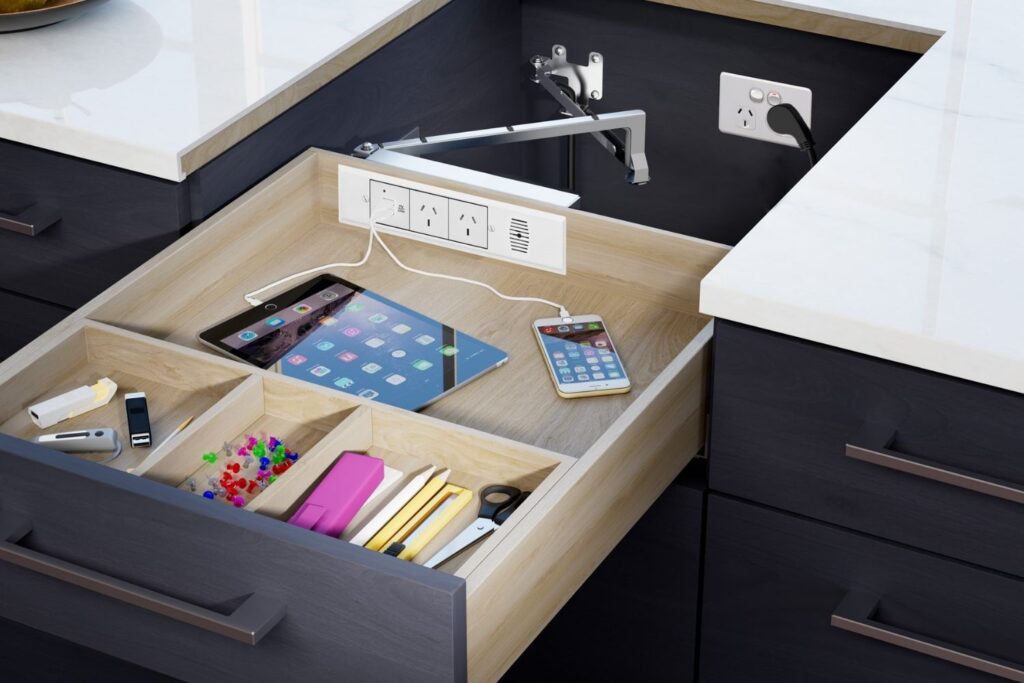
- Bedside Tables: Keep your smartphones and tablets charged overnight without cluttering your nightstand.
- Home Office: Organize your laptop, phone, and other devices in a dedicated charging drawer.
- Living Room: Create a convenient charging station for remotes, gaming controllers, and other electronics.
- Entryway: Charge your phone and other essentials as soon as you walk in the door.
The Future of Kitchen Design: Embracing Smart Solutions
Charging drawers are just one example of the growing trend towards smart solutions in kitchen design. As technology continues to evolve, we can expect to see even more innovative features that enhance functionality, convenience, and aesthetics. From smart appliances and voice-controlled lighting to integrated entertainment systems and automated storage solutions, the kitchen of the future will be a truly connected and intelligent space. Embracing these smart solutions will not only make our lives easier but also increase the value and appeal of our homes.
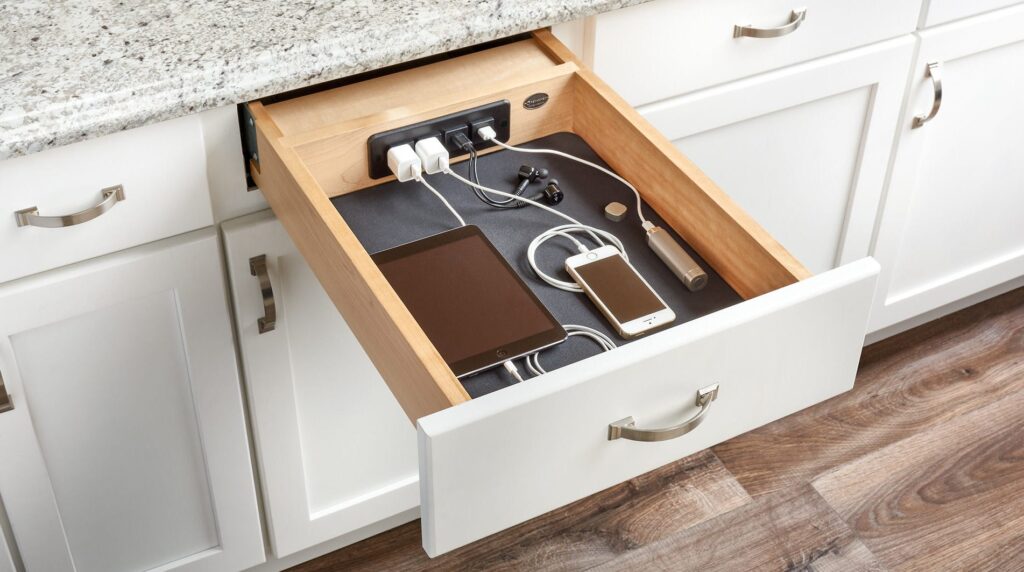
Transform Your Kitchen Today: Reclaim Your Space, Embrace Convenience
A charging drawer is more than just a convenient feature; it’s an investment in a more organized, efficient, and aesthetically pleasing kitchen. By decluttering your countertops, protecting your devices, and enhancing the overall design of your space, a charging drawer can transform your kitchen into a haven of culinary creativity and technological harmony. So, take the plunge and explore the world of charging drawer solutions. Whether you choose to build it yourself or purchase a pre-built unit, you’ll be amazed at the difference it makes. Reclaim your space, embrace convenience, and create the kitchen of your dreams.
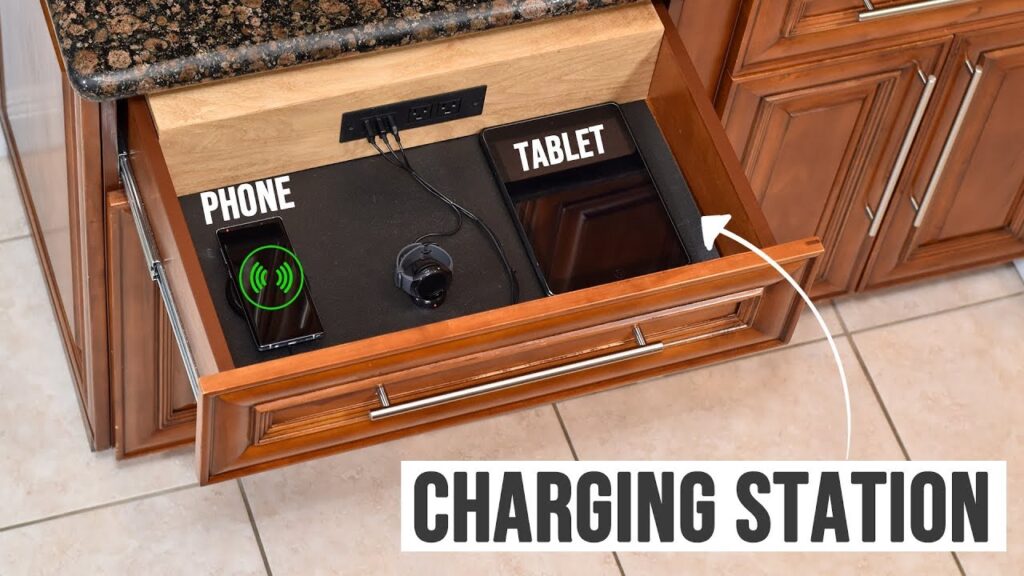
 Nimila
Nimila




